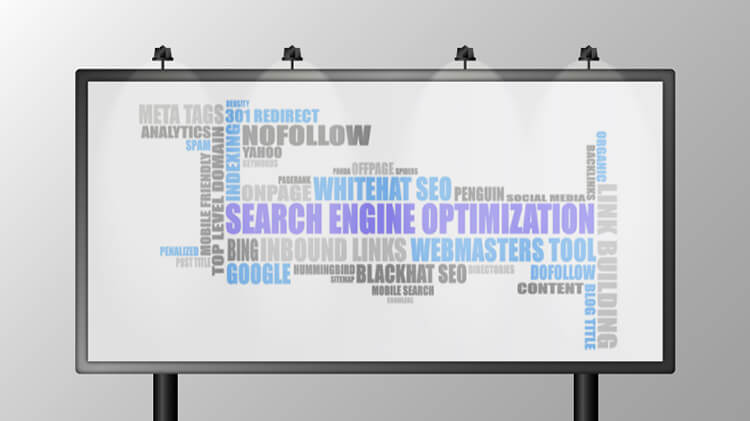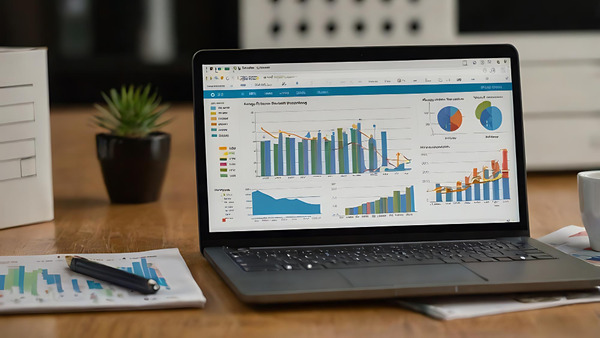Search Engine
Software system that is created to conduct a web search on the Internet systematically, looking for particular information written in a search box.
Algorithms
Multiplex computer programs that search engines use to collect data and show the best results for a query in SERP.
Alt Text (Alternative Text)
A word or a phrase that builds on image parts in HTML, used to describe the picture to customers and search engines.
AMP (Accelerated Mobile Pages)
AMP – is a aechnology for mobile web browsers that makes pages with a low network speed to load faster.
Anchor Text
Word or phrase that is used in the text of a link. Placed inside the <a> tags in HTML.
Backlinks
Links that lead from one site to another.
Black Hat SEO
An optimization method that uses scamming schemes to improve web pages and violates search engine’s webmaster guidelines. It includes link schemes, hidden text or link, cloaking, etc.
Bots
Computer programs made by search engines to surf the web. They automatically examine the website and collect the information for the search engine’s index in order to keep it up to date.
Browser
A software app to search for information on the Internet.
CF (Citation Flow)
CF – is a metric that shows the amount and how influential are links that are pointing to a website or URL.
Citations
In local SEO, it’s usually a reference to the title, phone number or address of a business.
Clickbait
Content that aims to attract people to your website by tricking them with misleading headlines, overpromising, falsely advertised hyperlinks, etc. It is considered a black tactic in SEO because it deceives visitors and lower brand trust.
Cloaking
A process of showing dissimilar versions of content to users and search engine bots in order to trick search engines and be higher in SERPs rank. Considered as a violation of Google’s Webmaster Guidelines.
Competition
There are two types: 1. Direct competitors have similar products or services and work with similar online and offline audiences; 2. SEO competitors have similar keywords for search visibility but different audiences and services.
Content
Words, pictures, videos, or sounds meant to be spread among and absorbed by the audience. It has to be useful, unique, and informative because it is a crucial Google ranking factor.
Crawl Budget
The counting of how many pages on your website Google will crawl during a certain amount of time
Crawling
A process where bots visit websites, analyze its content, gather and store it in a database.
CSS (Cascading Style Sheets)
CSS – is a mechanism that styles a visual of a web page (its colors, fonts, etc). Controls how these elements look like on a page on different devices.
CTR (Click-Through Rate)
CTR – is a metric that counts the number of clicks the advertisement gets.
DA (Domain Authority)
DA – is a ranking metric that foretells the success of a web page in SERPs ranking. It analyzes different aspects, such as the amount of inbound links, and counts out a DA score that scales from 1 to 100. The higher this score is, the better chances a website has to rank in Google.
Disavow Links
Links which you defined to Google as a threat to your website.
DNS (Domain Name System)
DNS – is a tool that converts a domain name of a website into the IP address, and then sends it to your device.
Dofollow
A link that doesn’t have a “Nofollow” attribute. Basically, it is a link which proceeds PageRank.
DR (Domain Rating)
DR – is a metric that shows both the quality and size efficiency of a website’s backlink profile. It measures on a scale from 1 to 100, where 100 – is the strongest domain possible.
Duplicate Content
A text content that partially or fully repeats elsewhere on the web.
External Link
A link that leads to the resource that is on the different website that the link was found on.
Featured Snippet
The block that pops up at the top of a Google Search page over the results. It can include short text, image, diagrams, etc. Also known as Position 0 because of its location on the search page.
Google Analytics
A web analytics instrument that follows the information about a website’s visitors, traffic, content performance, etc.
Googlebot
The web crawling system Google uses to look for and include new websites and web pages to its index.
The most used search engine founded in September 1998.
Google My Business
GMB – is a free of charge Google instrument that allows businesses to create a business profile for Google Search and Google Maps. It can also help to monitor the way your business is seen in local search requests.
Google Search Console (Google Webmaster Tools)
A free-of-charge service that provides website owners with access to data and instruments for optimizing these websites for Google search.
Grey Hat SEO
An optimization method that is between Black Hat SEO and White Hat SEO. It doesn’t always disobey the search engine’s guidelines but is also unsafe. It includes domain grabbing, link exchange, guest blogging, etc.
H1 Tag
An HTML tag that points out a heading on a site. Usually used in the first title you see on the page, and it is considered the most important one.
H2-H6 Tags
Elements that are used to identify HTML headings, where H1 is the most essential heading and H6 – the least essential one.
Homepage (Home Page)
A starting page of a website. It contains a navigational path to all the pages of a website, like a navigation center.
Hreflang
The operation of adapting the language of the website or web page to the user’s geolocation.
HTML (Hyper Text Markup Language)
HTML – is a typical markup language for creating web pages. Also, with the help of HTML tags, you can raise the SEO effectiveness of the website and web pages.
HTTP/HTTPS
Hypertext Transfer Protocol/Hypertext Transfer Protocol Secure – is a list of rules that allows to pass the data on the Internet and link web browsers and servers. The main distinction between HTTP and HTTPS is that HTTPS creates safe transactions between browser and server, protecting private information.
Image
Pages with images usually get more views that without. Moreover, by adding them to your website, you help search engines understand what content do you have on your web page. Can also be used for raising credibility to your brand.
Indexing
A data formation technique that permits to retrieve info from database records fast.
Index
A database of all the materials collected in the search engine, kind of like a library.
Internal Link
A link that leads to the resource that is on the same website that the link was found on.
IP address (Internet Protocol Address)
IP – is a number assigned to a specific computer or computer network. It allows computers to send and obtain information.
JavaScript
JS – is a kind of programming language that is used for showing sophisticated features on the website, like animations or interactive boards.
Keyword
A word or phrase used as a query in Google that helps users to find a website.
KPI (Key Performance Indicator)
KPI – evaluating method used in business and marketing to calculate whether its goals were achieved.
LSI (Latent Semantic Index)
LSI – is a program designed to recognize synonyms predicated on context. In SEO, it is used to build the connections between the keywords or phrases that have the same context as a main keyword.
Link Building
The process of placing the backlinks (or hyperlinks) to your website on trusted ones to make the search rank higher and increase the visibility of the site.
Link
A connection between websites made by HTML code. It redirects users from one resource or place on the page to another.
Local Search
A specialized search engine that contains not only the users‘ searching data (keywords, brand names, products, etc.) but also “where” info in a local business listing (street, address, geographic coordinates, etc.)
Meta Description
Description – A brief synopsis under the page’s title and URL in search results. Usually, it gives you a short summary of the page.
Meta Keywords
Keywords – is a kind of metatags in the HTML code that shows search engines what the subject of the page is.
Meta Tags
Tags – is the information in the HTML source code of a webpage that defines its material to the searching engines.
Mobile-first Indexing
A principle of ranking and indexing process, in which Google gives a priority to the mobile version of a web page.
Mobile Friendly Website
A website which size adapts to your mobile device and gets small enough to be displayed properly.
Nofollow
A rel=”nofollow” – is a link attribute that gives an understanding of which links on your website shouldn’t be taken into account by the searching engines; helps to resist the spam sites which can influence your search visibility.
Noindex Tag
A meta tag that makes search engines not to indicate a particular webpage in its tag.
Noopener
A rel=”noopener” – is an HTML attribute that is used to address a security vulnerability that could be applied by harmful websites.
Noreferrer
A rel=”noreferrer”A utility that tells browsers not to leak any HTTP referer info, and usually used with noopener to preserve the website.
Off-page (off-site) SEO
An SEO activity outside the site focused on brand recognition. It includes social media and content marketing, email newsletters, offline marketing channels, etc.
On-page (on-site) SEO
An SEO activity within the site focused on developing a website’s segments to optimize its search ranking. It includes posting qualitative, relevant content, improving HTML code, URL construction, website navigation, etc.
Organic Search Results
The organic request results that are calculated algorithmically, without the influence of the paid advertisement.
Organic Traffic
A users/visitors traffic that comes from the unpaid search engine queries.
PageRank
The scale of the significance of a web page grounded on the incoming links from different pages. Each link to your website from another one puts you higher in the PageRank.
PageSpeed Insights
It analyzes the efficiency of the web page, both on desktop and mobile devices, and then offers ways of its optimization.
Page Speed
The time that is needed for a web page to load completely.
Pagination
A sequential page numbering on a website, usually located on the top or the bottom of the web page. Usually, it’s used on the main page or website sections.
Panda
A content aimed algorithm. Usually, it’s a chain of changes to Google’s algorithms for ranking websites focused on improving results. Named after the engineer Navneet Panda.
Penguin
An update created to improve Google results that concentrate on link-related metrics.
PBN (Private Blog Network)
PBN – is a network of blogs made for SEO/link goals.
Protocol
A typical list of regulations that permits different gadgets to communicate with one another, such as what kind of data can be passed, kinds of commands to send and collect data, and how data transfers are approved.
RankBrain
A search engine algorithm created in 2015. Aimed at searching relevant and similar requests in Google Search.
Ranking
The position of the website on SERP in Google or other search systems.
Referring Domain
An outer website that refers visitors to your site. These domains have backlinks in them to increase traffic and views to chosen web pages.
Reputation Management
The process of designing a positive online impression of a person or brand.
Robots.txt (Robots Exclusion Standard)
Robots.txt – is a text file in the root of a website that tells search engine crawlers which parts of a website should be indexed and, and which one should be ignored.
ROI (Return On Investment)
ROI – is a profit that can be obtained from a service or action.
Root Domain
The shortest form of a domain name/URL, not taking into account a subdomain. For example, intltech.com is the root domain of http://www.intltech.com/.
Schema.org
A website created to produce, support, and develop schemas for structured data on the Internet, web pages, email messages, etc.
Screaming Frog
An SEO tool created to explore websites and detect SEO issues.
Search Intent
Also known as audience intent. It’s the reason why someone makes a concrete search. There are four basic kinds of search intent: informational, navigational, transactional, and commercial investigation.
Search Volume
A calculation instrument in keyword analysis which counts the approximate number of searches for a chosen keyword in search engine traffic.
Seasonal Trends
The frequency of search queries in Google depending on the season and the popularity of the production users are looking for.
SEO (Search Engine Optimization)
SEO – the operation of optimizing the website and its content by using proper keywords and key phrases in order to rank it on high positions in Google Search and enlarge its visibility for related searches.
SEO Audit
The detailed analysis of a website’s pages, structure, content, and some technical parameters to show its ability to pop up on SERPs. It also includes recommendations for usability improvements. The audit is conducted at the 1st stage of work.
SERP (Search Engine Results Page)
SERP – is the results you see after entering the request in the browser explore bar.
SERP Features
Every result on the Google Search page that is not a standard organic result. For example, instant answers, any visuals, best offers, etc.
Sitemap
A catalog of pages on a website. HTML sitemaps usually guide users through the website; XML helps search engine crawlers to index the web pages.
Social Signal
An interacting metric (such as likes, views, shares, etc.) on social media platforms (Facebook, Instagram, etc.). It impacts brand authority and ranking positions in search engines.
Spam
The methods that mislead and manipulate search engine algorithms and/or users.
SSL Certificate
SSL – is a data file that is demanded by Google to fully rank in the SERPs. It encrypts connections between web browsers and a web server.
Status Codes (Response Codes)
Response Status Codes – indicate whether a specific HTTP(s) request has been successfully completed. There are five classes defined by the standard: 1xx informational response, 2xx successful, 3xx redirection, 4xx client error, 5xx server error.
200 OK
200 OK – is a standard response to successful HTTP request accomplishment.
301 Moved Permanently
301 Moved Permanently – is an HTTP response status code pointing out that the searched resource has been permanently relocated to a new URL.
404 Not Found
404 Error – is a Hypertext Transfer Protocol (HTTP) response code that appears when a user tries to follow a broken or dead link.
500 Internal Server Error
500 Internal Server Error – is an internal error on a web server that means that it’s misconfigured and can’t answer properly.
Structured Data
A principle that makes it possible to note content so that Google and other web applications can take it into account. With structured data, you can get extended snippet results in Google for your web pages.
Technical SEO
The process of optimizing the technical features of a website and server to make SEO more effective. It includes such parts as crawling, indexing, internal linking, etc.
Title Tag
In Google and other searching systems is a clickable blue link above the URL and from above a browser tab. Usually, approximately 50-60 symbols, has the role of the title of a web page.
Trust Flow (TF)
TF – is a metric that shows the amount and reliability of links that are pointing to a website or URL.
Trust
Mostly relates to the history of the domain, its reputation, whether you can consider it a reliable source or not, etc.
Unique Content
The kind of content that is exclusive and has never been used before.
URL (Uniform Resource Locator)
URL – also known as web address. Defines the location of a website/web page/file and can lead you to them.
Usability
An index that describes how easily and effectively users can work with your website. A website that has high usability has easy navigation, understandable readability, quick page loading, and adapted to mobile devices.
User Experience (UX)
UX – the common feeling users are left with after using/getting to know a brand, its online representing, and its product/services.
Voice Search
A voice-activated technology that lets users conduct an online search by speaking into their device.
Website
A group of web pages and corresponding information that are united by one domain name.
White Hat SEO
This optimization method uses diverse search strategies that suit the search engine’s guidelines. It doesn’t include scamming, or other forbidden actions. Among White Hat SEO methods are creating top–quality content, using keywords, improving site load time, etc.
Yoast
A WordPress plugin that sets site pages to show correctly on search engines. It also gives you the instruments to improve your content to the highest standards of SEO.






